How to Grow Robellini Palms
- March 22, 2024
- 0 comment
Robellini palms, scientifically known as Dypsis decaryi, are a popular choice among gardening enthusiasts for their elegant appearance and relatively low maintenance requirements. These palms, native to Madagascar, can thrive both indoors and outdoors, making them versatile additions to any garden or interior space. However, like any plant, they require proper care to reach their full potential. Whether you’re a novice gardener or a seasoned green thumb, here’s a comprehensive guide on how to grow Robellini palms successfully.
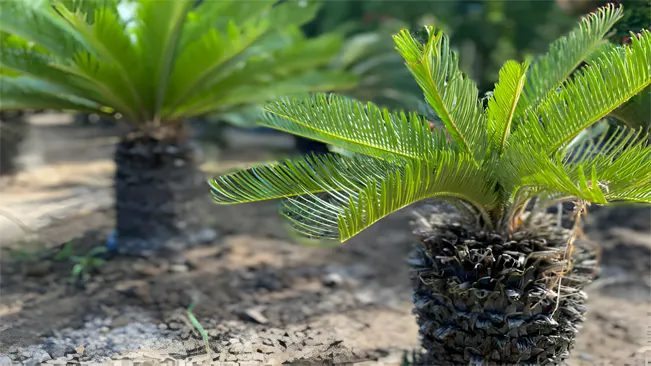
List on How To Grow Robellini Palms
- Understanding Robellini Palms
- Choosing the Right Location
- Soil Preparation
- Planting
- Watering
- Fertilization
- Pruning and Maintenance
- Protection from Frost
Understanding Robellini Palms
Robellini palms, scientifically known as Dypsis decaryi, are a species of palm native to Madagascar. These palms are widely appreciated for their striking appearance and relatively low maintenance requirements, making them a popular choice among gardeners and landscapers worldwide.
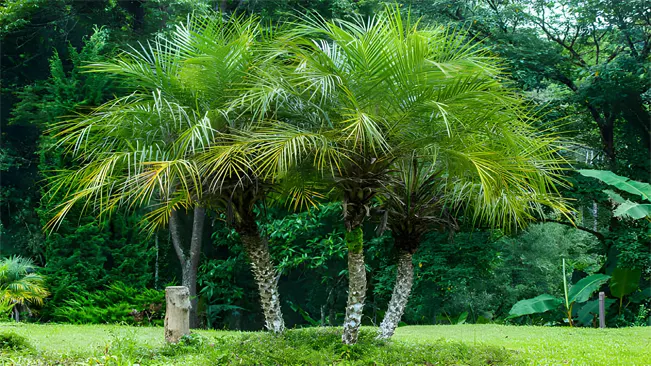
- Physical Characteristics: Robellini palms are characterized by their slender, green stems, which can grow up to 10 feet in height under optimal conditions. The stems are topped with a dense crown of feathery, arching fronds, giving the palm a graceful and tropical look. The fronds are typically dark green in color and can reach lengths of up to 3 to 5 feet. As the palm matures, it may develop a trunk that becomes more visible with age.
- Preferred Environment: Robellini palms thrive in warm, humid climates, making them well-suited for tropical and subtropical regions. They prefer temperatures ranging from 65°F to 85°F (18°C to 29°C) and require protection from frost and freezing temperatures, as they are not cold-hardy. These palms also prefer well-draining soil that retains moisture without becoming waterlogged. While they can tolerate a range of light conditions, from partial shade to full sun, they generally prefer bright, indirect sunlight for optimal growth.
- Adaptability: One of the notable characteristics of Robellini palms is their adaptability to various growing conditions. They can thrive both indoors and outdoors, making them versatile plants for landscaping or interior decoration. When grown indoors, Robellini palms benefit from exposure to bright, indirect sunlight and regular watering to maintain soil moisture levels. Outdoors, they can be planted in garden beds, borders, or containers, adding a tropical touch to patios, decks, or poolside areas.
Choosing the Right Location
Choosing the right location for your Robellini palms is essential for their overall health and growth. Whether you’re planting them outdoors in your garden or cultivating them indoors as houseplants, the location you choose will significantly impact their well-being.
Outdoor Cultivation
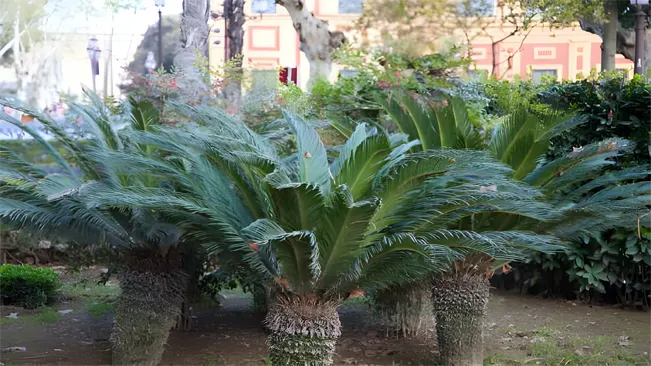
- When planting Robellini palms outdoors, it’s crucial to select a location that provides the ideal balance of sunlight and shade. These palms thrive in indirect sunlight or partial shade, particularly in regions with intense sunlight or high temperatures. Direct exposure to harsh sunlight can lead to leaf burn and other stress-related issues, so providing some protection is advisable.
- If your garden receives full sun for extended periods, consider planting the palms where they’ll receive filtered sunlight or shade during the hottest parts of the day. This can be achieved by positioning them near larger trees or structures that provide natural shade. Additionally, planting them on the eastern or northern side of your property can help shield them from the intense afternoon sun.
Indoor Cultivation
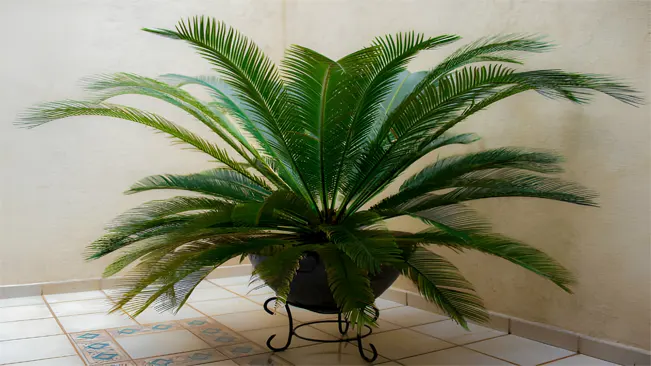
- For indoor cultivation, placement near a bright, sunny window is ideal for Robellini palms. These palms require ample sunlight to thrive, but it’s essential to avoid exposing them to intense, direct rays, which can scorch their delicate foliage. A south-facing window that receives indirect sunlight throughout the day is often the best choice. Alternatively, you can place them near east or west-facing windows where they’ll receive morning or afternoon sunlight, respectively.
- If you’re unable to provide sufficient natural light indoors, supplementing with artificial grow lights can help ensure your Robellini palms receive the energy they need for healthy growth. Position the grow lights above the palms and adjust the duration and intensity according to the plant’s requirements.
Additional Considerations
- Temperature: Robellini palms thrive in warm, humid environments and are sensitive to cold temperatures. Avoid planting them in areas prone to frost or freezing temperatures, as this can damage their foliage and stunt their growth.
- Air Circulation: Good air circulation is essential for preventing fungal diseases and promoting healthy growth. Avoid placing Robellini palms in areas with stagnant air, such as enclosed spaces or corners of a room.
- Soil Drainage: Ensure that the soil in outdoor planting beds or indoor containers provides adequate drainage to prevent waterlogging, which can lead to root rot. Choose a well-draining potting mix for container-grown palms and amend outdoor soil with organic matter to improve drainage.
Soil Preparation
Soil preparation is a critical step in ensuring the successful growth of Robellini palms. These palms thrive in soil that offers good drainage while retaining adequate moisture. To create an optimal growing environment for your Robellini palms, consider the following soil preparation tips
- Well-Draining Soil: Robellini palms prefer soil that drains well to prevent waterlogging, which can lead to root rot and other problems. A mixture of peat moss, perlite, and sand is highly recommended for improving drainage. Peat moss helps retain moisture while perlite and sand enhance soil structure, allowing excess water to drain away efficiently.
- Loose and Airy Texture: Before planting, ensure that the soil is loose and airy. Compacted soil can hinder root growth and lead to poor drainage. Use a garden fork or tiller to loosen the soil, breaking up any clumps and improving overall soil texture. Loose soil allows the roots to penetrate easily and access oxygen, promoting healthy growth.
- Incorporating Organic Matter: Adding organic matter such as compost is beneficial for enriching the soil with essential nutrients. Compost improves soil fertility and microbial activity, creating a conducive environment for root development. Mix well-aged compost into the soil before planting or use it as a top dressing around the base of the palm to provide a continuous source of nutrients.
- Balanced Nutrient Levels: Conduct a soil test to determine the pH and nutrient levels of the soil. Robellini palms prefer slightly acidic to neutral soil with a pH range of 6.0 to 7.0. If necessary, amend the soil with lime to raise the pH or sulfur to lower it. Ensuring balanced nutrient levels is essential for healthy growth and vibrant foliage.
- Mulching: Applying a layer of organic mulch around the base of the palm helps retain soil moisture, regulate soil temperature, and suppress weed growth. Use organic materials such as shredded bark, wood chips, or leaves as mulch. Avoid piling mulch directly against the trunk of the palm to prevent rotting and fungal issues.
Planting
By following these steps for planting Robellini palms, you can ensure that your palms have a strong start and are well-positioned to thrive in their new environment. Proper planting techniques promote healthy root development and increase the likelihood of success in growing vibrant, beautiful palms.
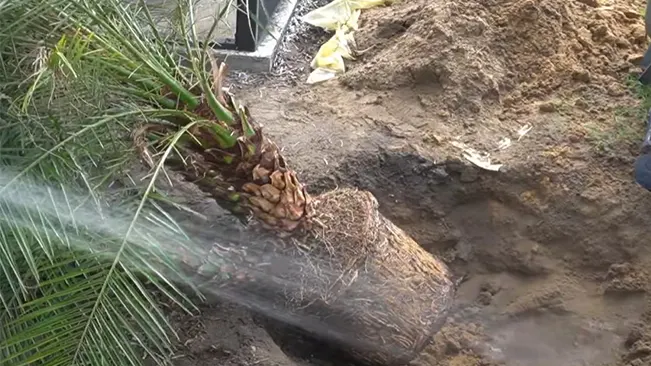
- Digging the Hole: Start by digging a hole in the planting area that is slightly larger than the root ball of the Robellini palm. The hole should be deep enough to accommodate the entire root system without bending or crowding the roots.
- Loosening the Roots: Once the hole is prepared, gently loosen the roots of the Robellini palm before placing it in the hole. This helps to encourage root expansion and allows the roots to penetrate the surrounding soil more easily.
- Positioning the Palm: Carefully lift the Robellini palm from its nursery container and place it in the center of the prepared hole. Position the palm so that the crown (where the foliage emerges) is at the same level as it was in the nursery container. This ensures that the palm is planted at the correct depth.
- Backfilling with Soil: After positioning the palm in the hole, backfill the hole with soil, gradually filling in around the roots. Use a mixture of the native soil and organic matter, such as compost, to improve soil fertility and provide essential nutrients. As you backfill, gently firm the soil around the roots to eliminate any air pockets.
Watering
Proper watering is crucial for the health of Robellini palms, especially during the establishment phase. Water the palm deeply but infrequently, allowing the soil to dry out slightly between waterings. Watering is a critical aspect of caring for Robellini palms, and understanding the right balance can make a significant difference in their health and growth.
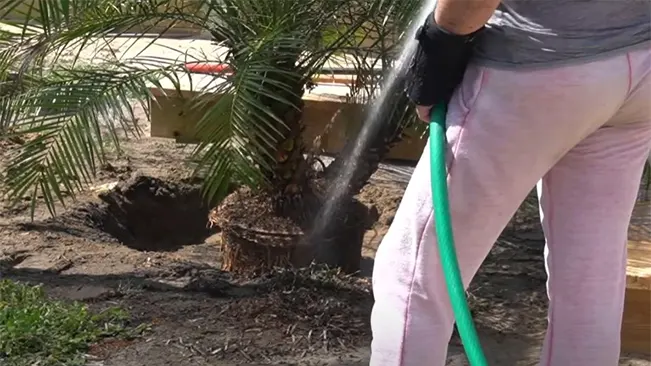
- Establishment Phase: When first planting a Robellini palm, pay special attention to watering during the establishment phase. This period typically lasts for the first few months after planting, during which the palm is acclimating to its new environment and developing its root system. Water the palm deeply but infrequently, ensuring that the root ball receives ample moisture without becoming waterlogged.
- Deep Watering: Rather than frequent, shallow watering, it’s important to water Robellini palms deeply. This encourages the roots to grow downward, establishing a strong and healthy root system. When watering, apply enough water to penetrate the soil to the depth of the root ball. This ensures that moisture reaches the entire root system, promoting even growth.
- Allowing Soil to Dry: After watering, allow the soil to dry out slightly before watering again. This allows excess moisture to drain away and prevents the soil from becoming waterlogged, which can lead to root rot and other issues. A good rule of thumb is to wait until the top few inches of soil feel dry to the touch before watering again.
- Monitoring Environmental Conditions: Pay attention to environmental factors such as temperature, humidity, and rainfall when determining watering frequency. During periods of hot weather or drought, the palm may require more frequent watering to prevent the soil from drying out completely. Conversely, during cooler or rainy periods, you may need to scale back watering to avoid waterlogged soil.
- Avoiding Excessive Saturation: While it’s important to provide adequate moisture to Robellini palms, it’s equally important not to saturate the soil excessively. Overwatering can lead to oxygen deprivation in the soil, which can suffocate the roots and promote the growth of harmful pathogens. Be cautious not to water too frequently or apply too much water at once, especially if the soil is already moist.
Fertilization
Regular fertilization is key to promoting robust growth and vibrant foliage in Robellini palms. Apply a balanced, slow-release fertilizer formulated for palm trees during the growing season, typically from spring to early fall. Avoid fertilizing during the winter months when the palm is dormant. Follow the manufacturer’s instructions for application rates, and avoid overfertilizing, as excessive nutrients can harm the palm’s roots.
- Timing: Fertilize Robellini palms during the active growing season, which typically spans from spring to early fall. During this period, the palm is actively producing new foliage and growing, making it more receptive to nutrient uptake from fertilizers. Avoid fertilizing during the winter months when the palm is dormant, as it doesn’t require additional nutrients during this time.
- Fertilizer Type: Choose a balanced, slow-release fertilizer specifically formulated for palm trees. These fertilizers contain a blend of essential nutrients, including nitrogen (N), phosphorus (P), and potassium (K), as well as micronutrients such as magnesium and iron. Slow-release formulas provide a steady supply of nutrients over time, reducing the risk of nutrient leaching and minimizing the need for frequent reapplication.
- Application Rates: Follow the manufacturer’s instructions regarding application rates and frequency. Typically, you’ll apply the fertilizer around the base of the palm, spreading it evenly within the drip line (the area beneath the outermost reach of the palm’s canopy). Avoid applying fertilizer directly to the trunk, as this can burn the sensitive tissue and lead to damage.
- Avoid Overfertilization: While fertilizer is essential for promoting healthy growth, it’s crucial not to overdo it. Overfertilization can lead to nutrient imbalances, salt buildup in the soil, and root damage. Follow recommended application rates carefully and resist the temptation to apply more fertilizer than necessary. Signs of overfertilization include yellowing or scorched leaf tips, stunted growth, and leaf drop.
- Watering After Fertilization: After applying fertilizer, water the palm thoroughly to help dissolve the nutrients and carry them down to the root zone. This also helps prevent fertilizer burn by flushing excess salts from the soil. Ensure that the soil is well-draining to prevent waterlogging, which can exacerbate nutrient imbalances and root rot.
- Adjusting Fertilizer Needs: Assess the palm’s growth and appearance regularly to determine if adjustments to the fertilization regimen are necessary. If the palm exhibits slow growth, pale foliage, or other signs of nutrient deficiency, consider increasing the frequency or dosage of fertilizer applications. Conversely, if the palm appears healthy and vigorous, maintain the current fertilization schedule to avoid overfeeding.
Pruning and Maintenance
Pruning and maintenance play vital roles in ensuring the health and aesthetic appeal of Robellini palms. While these palms generally require minimal pruning, it’s essential to know how to effectively maintain them for optimal growth and vigor.

Pruning
- Robellini palms naturally shed their older fronds to make room for new growth. However, occasional pruning may be necessary to remove dead, yellowing, or damaged fronds. Pruning not only improves the palm’s appearance but also prevents potential disease spread and reduces the risk of pest infestations.
- When pruning Robellini palms, it’s crucial to use clean, sharp pruning shears to make precise cuts. Dull or dirty tools can cause jagged cuts, increasing the risk of infection. Begin by inspecting the palm for any dead or discolored fronds. Carefully trim these fronds as close to the trunk as possible without damaging the healthy foliage.
- Avoid cutting into the trunk or healthy fronds, as this can leave the palm vulnerable to disease and nutrient loss. Additionally, refrain from removing too many green fronds at once, as this can stress the palm and impede its growth.
Maintenance
- Inspect Regularly: Regularly inspect the palm for signs of pests, such as scale insects, spider mites, or mealybugs, as well as fungal infections or other diseases. Early detection allows for prompt treatment, minimizing damage to the palm.
- Watering: Monitor the soil moisture levels and adjust watering accordingly. Robellini palms prefer slightly moist, well-draining soil. Avoid overwatering, as this can lead to root rot and other moisture-related issues. Similarly, ensure that the soil doesn’t dry out completely between waterings, especially during hot weather.
- Fertilization: Feed Robellini palms with a balanced, slow-release fertilizer during the growing season to provide essential nutrients for healthy growth. Follow the manufacturer’s instructions for application rates and timing, and avoid overfertilizing, as this can cause fertilizer burn and other problems.
- Protection from Frost: If you live in a region with occasional frost or freezing temperatures, take precautions to protect your Robellini palms during the winter months. Cover the palm with frost cloth or move container-grown palms indoors to prevent cold damage to the foliage.
- Mulching: Apply a layer of organic mulch around the base of the palm to help retain moisture, suppress weed growth, and regulate soil temperature. Keep the mulch away from the trunk to prevent rot and fungal diseases.
Protection from Frost
Protection from frost is essential for ensuring the health and vitality of Robellini palms, especially in regions where temperatures frequently drop below freezing. While these palms exhibit a degree of cold tolerance, prolonged exposure to frost can result in damage to the foliage and even the death of the palm if precautions are not taken.
- Understanding Frost Tolerance: Robellini palms are more cold-hardy than many other palm species, with the ability to withstand temperatures down to approximately 25°F (-4°C) for short periods. However, extended exposure to freezing temperatures or sudden temperature drops can cause significant damage to the palm’s tender foliage.
- Monitoring Weather Conditions: Stay informed about weather forecasts, particularly during the winter months when frost is most likely to occur. Pay attention to predicted temperature lows and frost advisories for your area. Be prepared to take action to protect your palms if temperatures are expected to drop near or below freezing.
- Covering Palms: One effective method of frost protection is covering the palms with frost cloth or blankets. Before nightfall when temperatures are expected to dip, drape the fabric over the palm, ensuring that it reaches all the way to the ground. Secure the edges of the cloth with weights or stakes to prevent it from blowing away in the wind. The fabric acts as insulation, trapping heat radiating from the ground and creating a microclimate that helps keep the palm warmer.
- Using Heat Sources: In extreme cold conditions, supplemental heat sources can provide additional protection for Robellini palms. Wrapping outdoor palm trunks with heat tape or string lights can generate enough warmth to mitigate frost damage. Alternatively, placing portable heaters or heat lamps near the palm can help raise the ambient temperature in the immediate vicinity, reducing the risk of frost damage.
- Moving Container-Grown Palms: If you’re growing Robellini palms in containers, consider moving them indoors during periods of extreme cold or frost. Place the containers in a well-lit area away from drafty windows or doors to ensure they receive adequate light and warmth. Monitor indoor palms for signs of stress, such as yellowing leaves or wilting, and adjust care accordingly.
- Mulching: Applying a thick layer of organic mulch around the base of outdoor palms can help insulate the soil and roots, providing additional protection against frost. Mulch acts as a barrier, reducing heat loss from the ground and maintaining more stable soil temperatures. Use materials such as shredded bark, straw, or compost, and spread the mulch evenly in a layer several inches deep around the base of the palm.
- Pruning: Avoid pruning Robellini palms in late fall or winter, as freshly exposed cuts are more susceptible to frost damage. Pruning stimulates new growth, which is particularly vulnerable to cold temperatures. Instead, wait until after the threat of frost has passed in spring before undertaking any pruning activities.
Conclusion
Growing Robellini palms can be a rewarding experience, whether you’re cultivating them as ornamental specimens in your garden or as indoor accents. By providing the right growing conditions, including proper sunlight, well-draining soil, and adequate moisture, you can enjoy lush, healthy palms for years to come. Remember to monitor your palms regularly for signs of stress or disease and take appropriate action to address any issues promptly. With care and attention, your Robellini palms will flourish and enhance the beauty of their surroundings.
FAQs (Frequently Asked Questions)
- What are the ideal growing conditions for Robellini palms?
- Robellini palms thrive in warm, humid environments with well-draining soil. They prefer partial shade to full sun and are adaptable to various light conditions.
- Robellini palms thrive in warm, humid environments with well-draining soil. They prefer partial shade to full sun and are adaptable to various light conditions.
- How often should I water Robellini palms?
- Water Robellini palms deeply but infrequently, allowing the soil to dry out slightly between waterings. During hot weather or drought, increase watering frequency to prevent the soil from drying out completely.
- Water Robellini palms deeply but infrequently, allowing the soil to dry out slightly between waterings. During hot weather or drought, increase watering frequency to prevent the soil from drying out completely.
- Do Robellini palms require fertilizer?
- Yes, regular fertilization is beneficial for Robellini palms. Apply a balanced, slow-release fertilizer formulated for palm trees during the growing season, typically from spring to early fall.
- Yes, regular fertilization is beneficial for Robellini palms. Apply a balanced, slow-release fertilizer formulated for palm trees during the growing season, typically from spring to early fall.
- How tall do Robellini palms grow?
- Robellini palms can reach heights of up to 10 feet when grown in optimal conditions. However, their growth rate can vary depending on factors such as sunlight, soil quality, and watering practices.
- Robellini palms can reach heights of up to 10 feet when grown in optimal conditions. However, their growth rate can vary depending on factors such as sunlight, soil quality, and watering practices.
- Are Robellini palms suitable for indoor cultivation?
- Yes, Robellini palms can be grown indoors in containers as long as they receive adequate light and humidity. Place them near a sunny window and mist the foliage regularly to maintain humidity levels.
- Yes, Robellini palms can be grown indoors in containers as long as they receive adequate light and humidity. Place them near a sunny window and mist the foliage regularly to maintain humidity levels.
- How do I protect Robellini palms from frost?
- To protect Robellini palms from frost, cover them with frost cloth or blankets, use heat sources such as heat tape or heaters, move container-grown palms indoors during cold snaps, and apply mulch around the base for insulation.
- To protect Robellini palms from frost, cover them with frost cloth or blankets, use heat sources such as heat tape or heaters, move container-grown palms indoors during cold snaps, and apply mulch around the base for insulation.
- Do Robellini palms require pruning?
- Pruning requirements for Robellini palms are minimal. Remove dead or yellowing fronds to improve appearance and prevent disease spread. Avoid pruning during late fall or winter, as fresh cuts are susceptible to frost damage.
- Pruning requirements for Robellini palms are minimal. Remove dead or yellowing fronds to improve appearance and prevent disease spread. Avoid pruning during late fall or winter, as fresh cuts are susceptible to frost damage.
- Are Robellini palms susceptible to pests or diseases?
- While generally resistant to pests and diseases, Robellini palms can occasionally be affected by scale insects, fungal infections, or nutrient deficiencies. Regular monitoring and proper care can help prevent and address these issues.
- While generally resistant to pests and diseases, Robellini palms can occasionally be affected by scale insects, fungal infections, or nutrient deficiencies. Regular monitoring and proper care can help prevent and address these issues.
- Can I propagate Robellini palms?
- Yes, Robellini palms can be propagated through seeds or by dividing mature clumps. Seed propagation requires patience as it can take several months for seeds to germinate and establish. Division involves separating offsets from the parent plant and replanting them in suitable soil.
- Yes, Robellini palms can be propagated through seeds or by dividing mature clumps. Seed propagation requires patience as it can take several months for seeds to germinate and establish. Division involves separating offsets from the parent plant and replanting them in suitable soil.
- How long does it take for Robellini palms to mature?
- Robellini palms typically take several years to reach their full mature height and appearance. Growth rates can vary depending on environmental conditions and care practices, but with proper care, they can become impressive specimens in the landscape.
For more expert gardening and advice, explore our guides, discover top recommendations in our best section, and delve into in-depth product reviews in our review section. Happy Gardening.

Kristine Moore
Forestry AuthorI'm Kristine Moore, a seasoned garden landscaping professional with over 30 years of experience. My extensive career has been dedicated to transforming outdoor spaces into stunning, sustainable landscapes. With a deep understanding of horticulture, design principles, and environmental stewardship, I have become a respected figure in the field, known for creating harmonious, visually appealing, and eco-friendly gardens. My commitment to excellence and continuous learning in landscaping trends and techniques has solidified my reputation as an expert in garden design and implementation.

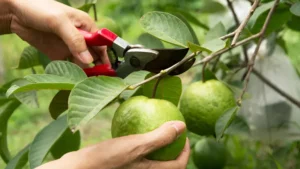











Leave your comment